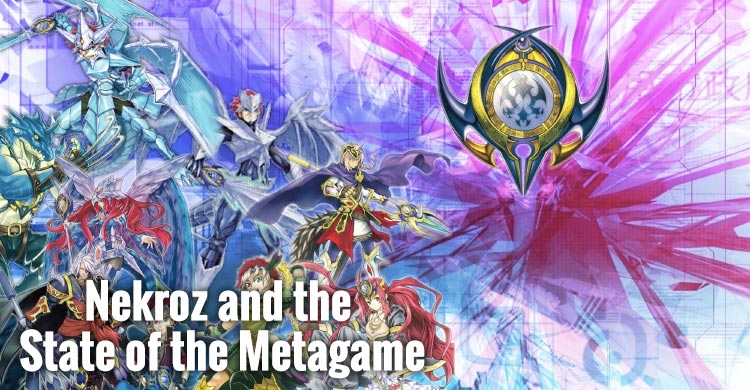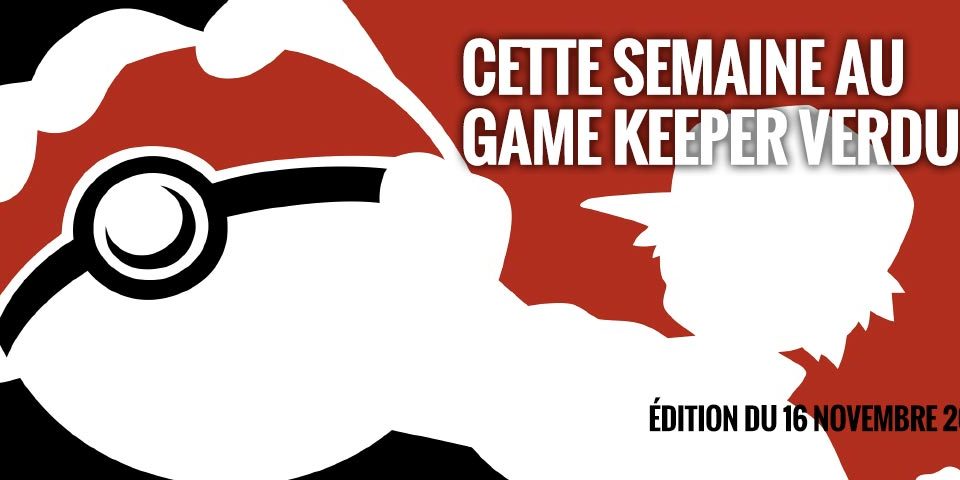PPTQ en mars
2015/02/10
Dragons of Tarkir Prerelease
2015/03/16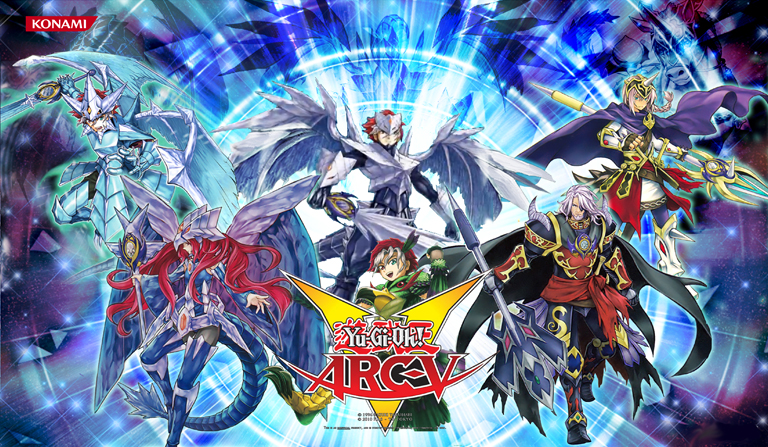 Hello Yu-Gi-Oh! players. My name is Jordan, and some of you may know me for head judging Regional events in Montreal over the past few years. I haven’t written an article for quite some time now for Game Keeper, but when the store owners asked me to write something up on Nekroz, I just couldn’t resist the temptation.
Hello Yu-Gi-Oh! players. My name is Jordan, and some of you may know me for head judging Regional events in Montreal over the past few years. I haven’t written an article for quite some time now for Game Keeper, but when the store owners asked me to write something up on Nekroz, I just couldn’t resist the temptation.
My closest friends know that I love to play in formats where the metagame is very technical. As such, some of my very favorite formats over the years have been Goat Control, TeleDAD, and Dragon Ruler format. By technical, I mean that these formats are 1-deck formats where mirror matches are very common. Knowing how to win the mirror match, and making tech choices for it while not compromising matchups against other competitive decks is crucial. It’s all about finding the right balance between consistency, power, and tech choices. Moreover, learning the intricacies of the mirror match will often lead you to success. For Goat Control, a key to the mirror match was control the tempo. In TeleDAD, it was all about conserving Solemn Judgements for the right moment. For Dragon Rulers, it was all about playing around Crimson Blader and resource management.
The Nekroz Mirror
If we lend credence to the results from YCS Tacoma, it appears that we are moving towards a format where Nekroz is likely the best deck of the format after taking 22 of the top 32 spots. So this leaves us with figuring out how to win the mirror match.
There are generally 3 things that happen in the mirror match (note that I won’t discuss how to perform the combos, as that isn’t the point of this article):
1. Open the combo pieces
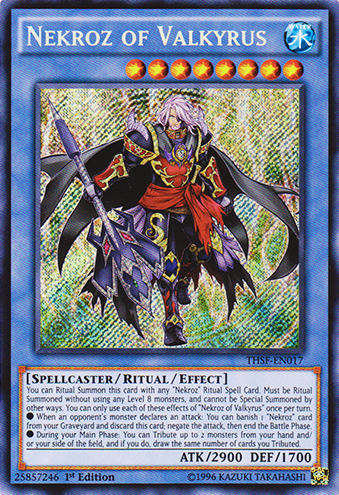 First, if you open the combo pieces, you set up a Djinn Releaser of Rituals lock on turn one with protection from Nekroz of Valkyrus in hand. This play isn’t very common, but if they do combo off, players are resorting to playing multiple copies of Book of Eclipse and any combination of Book of Moon, Raigeki, or even Dark Hole. We even saw one player main deck D.D. Warrior Lady (a target for Reinforcement of the Army) as an out to the Djinn Releaser of Rituals combo.
First, if you open the combo pieces, you set up a Djinn Releaser of Rituals lock on turn one with protection from Nekroz of Valkyrus in hand. This play isn’t very common, but if they do combo off, players are resorting to playing multiple copies of Book of Eclipse and any combination of Book of Moon, Raigeki, or even Dark Hole. We even saw one player main deck D.D. Warrior Lady (a target for Reinforcement of the Army) as an out to the Djinn Releaser of Rituals combo.
2. Nekroz loop
The more common play is to attack with Nekroz of Valkyrus and some other monster to deal damage (or bait out their own Nekroz of Valkyrus), then use Valkyrus’ effect to tribute off both monsters and draw 2 cards. Then you discard The Nekroz of Unicore (or search another Nekroz of Valkyrus if need be) to prevent yourself from an OTK. Why would you leave your field open, you may ask. The answer is rather simple: so you don’t leave yourself open to a Nekroz of Trishula play. Then, if they put up a scary board, you can use Valkyrus’ effect to prevent substantial damage. Both players will exchange Valkyrus loops until one player runs out of resources or bricks. It is precisely for the purpose of Nekroz of Valkyrus loops that myself and many other top players are not fond of the Inzektor Exa-Beetle combo in Nekroz. Wasting 2 Nekroz of Brionacs for this play is enough to warrant some skepticism for this combo, but leaving your field with a Gaia Dragon the Thunder Charger and Shooting Star open to a Nekroz of Trishula next turn isn’t intelligent in the mirror match. Nekroz of Valkyrus would not be able to clear itself, Shooting Star and Gaia Dragon the Thunder Charger from the field. It was very evident at YCS Tacoma that many players also had the same doubts about the Exa-Beetle combo as none of the top 32 decklists (that have been released to date) actually played the combo. It goes without saying that you also have to dedicate 3 extra cards to your Extra deck for this combo. Although this combo might be powerful vs other decks, there are usually better plays available to you in you have a Nekroz of Brionac(s) and Nekroz Kaleidoscope in your hand.
3. Getting behind in the match
The third scenario is when one player does not open a Nekroz of Valkyrus loop, by which point they are severely behind in the mirror match.
Adapting to the Nekroz Mirror
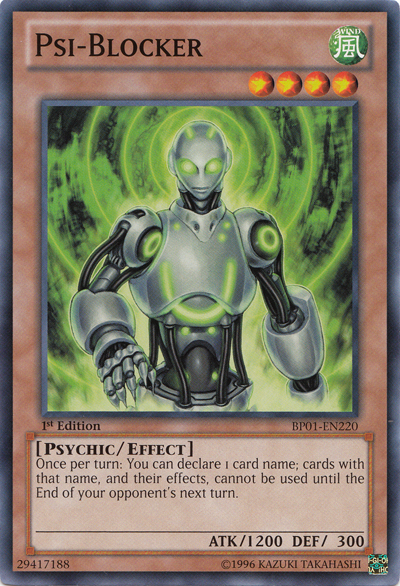 There is a popular card that you should expect to see more play in Nekroz right now: Psi-Blocker. In Nekroz, you can easily put 8000 damage on board, but the issue is whether to do it in the mirror. If you over-commit to the field, and cannot Valkyrus your field away, you risk getting hit by Nekroz of Trishula next turn. As such, you need a pseudo “Denko Sekka” for the mirror match which lets you prevent them from using Valkyrus’ effect to end the battle phase. Psi-Blocker is exactly the card that lets you do it. Your own Valkyrus’ put in work when it comes to digging deep into the deck for Psi-Blocker, especially with all the searching and deck thinning Nekroz does. With Psi-Blocker, you simply call “Nekroz of Valkyrus” to ensure your OTK is successful.
There is a popular card that you should expect to see more play in Nekroz right now: Psi-Blocker. In Nekroz, you can easily put 8000 damage on board, but the issue is whether to do it in the mirror. If you over-commit to the field, and cannot Valkyrus your field away, you risk getting hit by Nekroz of Trishula next turn. As such, you need a pseudo “Denko Sekka” for the mirror match which lets you prevent them from using Valkyrus’ effect to end the battle phase. Psi-Blocker is exactly the card that lets you do it. Your own Valkyrus’ put in work when it comes to digging deep into the deck for Psi-Blocker, especially with all the searching and deck thinning Nekroz does. With Psi-Blocker, you simply call “Nekroz of Valkyrus” to ensure your OTK is successful.
Psi-Blocker also has huge implications in turning off continuous effects (not lingering effects such as Djinn Releaser of Rituals), for instance, Vanity’s Emptiness if you happen to be playing against Burning Abyss or Qliphort.
Another key card that will see play in Nekroz (if the trend maintains and the majority of people play Nekroz) is Shared Ride. This card saw heavy play in 3s in the OCG, in the main deck. Many Nekroz players are considering cutting Mystical Space Typhoon (nearly useless in the mirror during game 1) or even Maxx “C” for Shared Ride because it is a vital card in the mirror match. The card is also good vs. Qliphort, meaning that the cards’ overall utility increases as it becomes versatile.
Streamlining your deck towards a more optimal build, in response to the YCS Tacoma builds, is a good place to start. Adapting your deck for winning the mirror match means that you may exclude key cards in the main deck while that might make your matchup against other decks worse. Removing Mystical Space Typhoon has its merits as it outs Vanity’s Emptiness, however, in a 10 Round Event, you should be confident in your side deck’s ability to bail you out in game 2 and 3 against decks not called Nekroz. If we are to expect more mirror matches at future events, this strategy can be very useful in adjusting for the mirror match.
How Other Decks Adapt
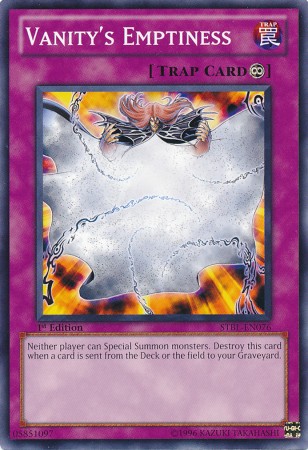 Decks like Burning Abyss and Qliphort can certainly adapt to Nekroz. Both decks will have to move towards a trap-heavier build to help contain Nekroz. The advantage of playing trap heavy for a deck like B.A is that although you are slowing the pace of your deck down, it adds an indisputable mix of power and defense to your build. It has been well documented by now that B.A can work very well with discard traps which serve the purpose of remove threats while triggering B.A monster effects.
Decks like Burning Abyss and Qliphort can certainly adapt to Nekroz. Both decks will have to move towards a trap-heavier build to help contain Nekroz. The advantage of playing trap heavy for a deck like B.A is that although you are slowing the pace of your deck down, it adds an indisputable mix of power and defense to your build. It has been well documented by now that B.A can work very well with discard traps which serve the purpose of remove threats while triggering B.A monster effects.
The return of Fire Lake of the Burning Abyss, Vanity’s Emptiness, Karma Cut, Phoenix Wing Wind Blast, et al. allows Burning Abyss to adapt to Nekroz while still maintaining a favorable Qliphort matchup.
For Qliphort, the transition from floodgate builds to trapless builds since Secrets of Eternity has been a contributing factor towards improving the Burning Abyss matchup. The return to floodgate builds (main decking, notably, Vanity’s Emptiness and Skill Drain) gives the deck a very good game 1 matchup vs. Nekroz. However, this necessary change leaves Qliphort more vulnerable to Fire Lake against Burning Abyss. For Qliphort, adaptation will hinge on finding the right balance between dealing with Nekroz while not compromising the mirror match and the Burning Abyss matchup.
Expect Vanity’s Emptiness to make its way back into Shaddoll, B.A, and Satellars. This is a card that put in heavy work, especially game 1 Mystical Space Typhoon is removed from Nekroz main decks to make room for Shared Ride.
One card that is seeing popularity as an out to Nekroz is Spell Canceller. Expect to see this card in more side decks at future events. Nekroz can only really out this card with Dance Princess of the Nekroz or Great Sorcerer of the Nekroz coupled with Nekroz of Decisive Armor (excluding counter side deck cards, which will be discussed soon).
One thing is certain – we can certainly expect other decks to get very creative in side deck and main deck choices in the adaptation for survival in a format where Nekroz is a very real threat.
How Nekroz Counter-Adapts
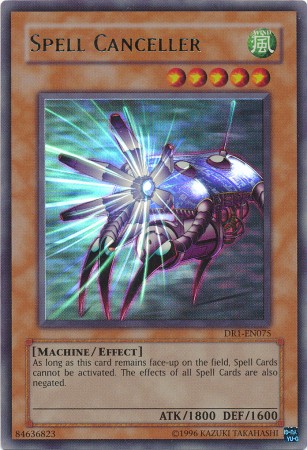 I’ve already discussed cards such as Psi-Blocker and Shared Ride to counter the mirror match and, to a certain degree, the other tier 1-2 decks of the format. But how does Nekroz adapt to heavier trap builds and cards like Spell Canceller?
I’ve already discussed cards such as Psi-Blocker and Shared Ride to counter the mirror match and, to a certain degree, the other tier 1-2 decks of the format. But how does Nekroz adapt to heavier trap builds and cards like Spell Canceller?
One answer to the trap-heavy versions of Burning Abyss and Qliphort is Denko Sekka. After all, OCG decks began main-decking Denko Sekka. But how does Denko Sekka deal with Spell Canceller? Another answer could be, perhaps, Fire and Ice Hand. The hands put in tremendous work vs. floodgates and they can cause serious problems for a deck like Qliphort.
The fact remains that the decklists you saw at YCS Tacoma will be very different than what you will see at the March 2014 Montreal Regional and onward. Keep in mind that all these tech choices apply to larger events such as Regionals and YCS’ as you should expect to play against Nekroz, B.A and Qliphort ad nauseum. At locals, however, that may be different as other players will play with other interesting decks, such as Yosenju, Shaddoll, or Satellarknight.
Thank you for taking the time to read this article, and I hope it has been of some use to you! See you all at the next Regional tournament, and don’t forget to check out gamekeeperonline.com for amazing online prices for all the singles and product you need to help you adapt for this upcoming meta.

